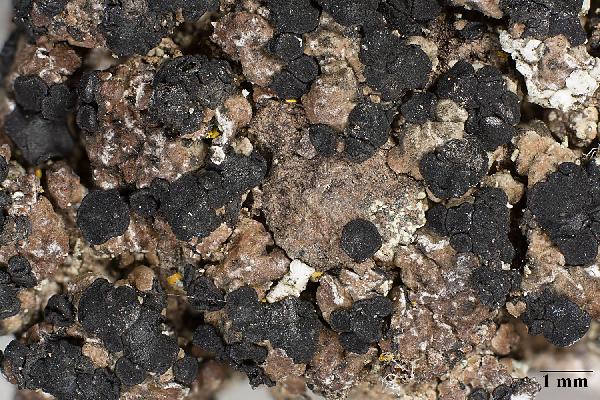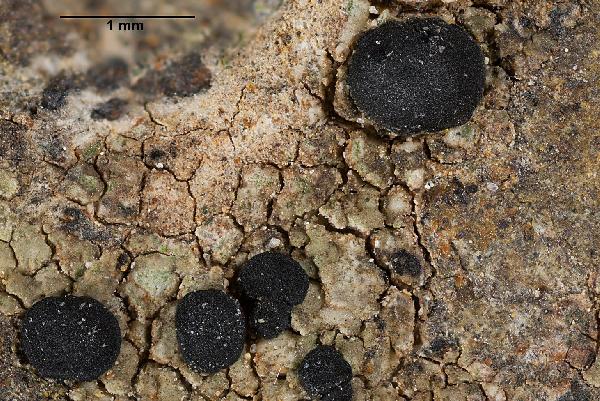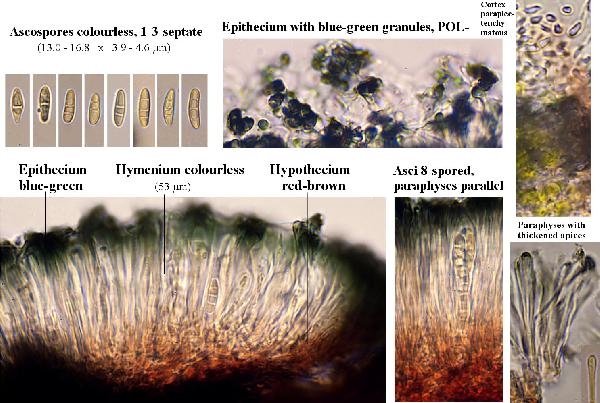Toniniopsis coprodes (Körb.) S. Ekman & Coppins
in Cannon & al., Revisions of British and Irish Lichens 11: 76, 2021. Basionym: Bilimbia coprodes Körb. ex Arnold - Flora, 41: 503, 1858.
Synonyms: Bacidia coprodes (Arnold) Lettau; Bacidia granosa (Tuck.) Zahlbr.; Bacidia salevensis (Müll. Arg.) Zahlbr.; Bacidia subtrachona (Arnold) Lettau; Biatora trachona auct. p.p.; Bilimbia subtrachona Arnold
Description: Thallus crustose, thin, pale green, grey-green to brownish green, finely warted-areolate or more or less granular, the granules 0.06.0.25 mm in diam, sometimes delimited by a whitish, arachnoid prothallus. Apothecia lecideine, 0.3-1.2 mm across, sessile and constricted at base, orbicular to irregularly lobed, dark brown to black, with an initially flat, then more or less convex, epruinose or (rarely) thinly white-pruinose disc, and a concolorous, often glossy, finally often excluded proper margin. Proper exciple red-brown to greenish black, 47-78 μm wide laterally, of radiating hyphae, containing a red-brown (K+ purplish, N+ orange-red) and a greenish pigment (K+ intensifying green, N+ purple, with deposition of blue crystals); epithecium scarcely differentiated from the hymenium, green (sometimes patchily); hymenium 50-65 μm high, colourless in lower part, merging with the epithecium in upper part, I+ blue; paraphyses 1.5-2.8 μm thick at mid-level, simple or sparingly branched in upper part, rarely anastomosing, the apical cells clavate or some not thickened, 2.5-5 μm wide; hypothecium dark red-brown to greenish black in upper part, almost colourless in lower part. Asci 8-spored, clavate, surrounded by a gelatinous I+ blue coat, with a well-developed I+ blue tholus with a darker blue tube and a well-developed ocular chamber, Bacidia-type. Ascospores 3(-5)-septate, hyaline, straight or slightly curved, bacilliform or narrowly ellipsoid, with blunt ends, 10-20 x 2.5-4.5 μm. Pycnidia semi-immersed in thallus, projecting with the dark brown to black ostiolar region, the wall with a brown (K+ purplish, N+ orange-red) pigment in upper part. Conidia 1-celled, of two types: a) short-bacilliform, narrowly ellipsoid or tear-shaped, straight, 3-10 x 1.5–2.8 μm, or, b) filiform, curved, 6–20 x 0.8-1.0 μm. Photobiont chlorococcoid, the cells 5-12 μm in diam. Spot tests: thallus K-, C-, KC-, P-, UV-. Chemistry: thallus without lichen substances.
Growth form: Crustose
Substrata: rocks
Photobiont: green algae other than Trentepohlia
Reproductive strategy: mainly sexual
In underhangs rarely wetted by rain
Commonnes-rarity: (info)
Alpine belt: absent
Subalpine belt: absent
Montane belt: extremely rare
Dry submediterranean belt: extremely rare
Humid submediterranean belt: extremely rare
Padanian area: absent
pH of the substrata:
1 2 3 4 5
Solar irradiation:
1 2 3 4 5
Aridity:
1 2 3 4 5
Eutrophication:
1 2 3 4 5
Poleotolerance:
0 1 2 3
Altitudinal distribution:
1 2 3 4 5 6
Rarity
absent
extremely rare
very rare
rare
rather rare
rather common
common
very common
extremely common
Loading data...
Occurrence data
Predictive map

Ulrich Kirschbaum CC BY-SA 4.0 - Source: https://www.thm.de/lse/ulrich-kirschbaum/flechtenbilder
E; Canary Islands; La Gomera-NW; s of Vallehermoso: Camino Forestal de la Meseta. On volcanic rocks
Growth form: Crustose
Substrata: rocks
Photobiont: green algae other than Trentepohlia
Reproductive strategy: mainly sexual
In underhangs rarely wetted by rain
Commonnes-rarity: (info)
Alpine belt: absent
Subalpine belt: absent
Montane belt: extremely rare
Dry submediterranean belt: extremely rare
Humid submediterranean belt: extremely rare
Padanian area: absent
pH of the substrata:
| 1 | 2 | 3 | 4 | 5 |
Solar irradiation:
| 1 | 2 | 3 | 4 | 5 |
Aridity:
| 1 | 2 | 3 | 4 | 5 |
Eutrophication:
| 1 | 2 | 3 | 4 | 5 |
Poleotolerance:
| 0 | 1 | 2 | 3 |
Altitudinal distribution:
| 1 | 2 | 3 | 4 | 5 | 6 |
Rarity
absent
extremely rare
very rare
rare
rather rare
rather common
common
very common
extremely common
Loading data...
Occurrence data
Predictive map









